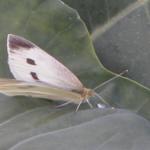Imported Cabbageworm
Pieris rapae
Identification:
This familiar white butterfly can be seen in daytime fluttering around cole crop fields. Each forewing has a dark border and one or two round black spots. Eggs are laid singly on the underside or top of leaves, about 1/8 inch in length, light green and slightly elongated, standing upright. The caterpillar, called imported cabbageworm, is gray-green, slightly fuzzy, and sluggish. Feeding and resting occur on the underside of leaves, and larvae feed more heavily in the head of cabbage or broccoli as they grow. The crysalis (pupa) will be green or brown, smooth with three pointed ridges on its back, and attached to a leaf.
Quick Identification Cues for the three key caterpillars of Brassica crops in the Northeast:
Diamondback moth catperillar: very wiggly when poked, pointed on both ends, not fuzzy, only grows to about ½ inch. You may find white silken cocoons, with a green full-grown catperillar or a brown pupa inside.
Imported cabbageworm: gray-green, slightly fuzzy, and sluggish. Grows to > 1 inch and favors the center of the head as it gets larger. Produces wet green frass (droppings).
Cabbage looper: light green, smooth, ‘loops’ up like an inchworm as it moves, grows 1 ½ to 2 inches. Eats big holes in leaves.
Life Cycle:
There are 3-4 generations per year in central New England.
Monitoring & Thresholds:
It is especially important to check cabbage or broccoli plantings as they begin forming heads. Greens such as collards, kale, and Chinese cabbage should be scouted earlier, since all leaves are marketed. Feeding damage can be found on the underside of leaves or in the center of the plant where heads are forming. Look for tiny feeding holes, clustered together. Often it is easier to spot the feeding damage first, and then find the caterpillar. Check throughout the field and note how many have one or more caterpillar (ie, are “infested”), then calculate the percent of plants infested. Spray if the following threshold is reached.
Action thresholds for caterpillars in Brassicas:
| Crop | Stage | % Infested Plants |
|---|---|---|
| Cabbage & Broccoli, Cauliflower | pre-cupping (before head formation begins) | 35% |
| Cabbage & broccoli | head formation to maturity | 15% |
| Cauliflower | After heading | 10% |
| Kale, collards & other greens | 10-15% |
These thresholds are based on research that showed that spraying whenever this level of infestation is reached results in 98-100% clean heads, the equivalent of weekly sprays but with far fewer insecticide applications.
Cultural Controls & Prevention:
See the New England Vegetable Management Guide for insecticides. There are many effective options. Use selective products to protect beneficial insects that keep aphids under control, and also consume insect eggs and small caterpillars.
Biological Controls:
In 1988, a braconid wasp (Cotesia rubecula) was imported from China by Roy Van Driesche of the UMass Plant Soil and Insect Science Department, and released at 17 locations in Massachusetts. It has become well established; surveys conducted in 2007 and 2009 found parasitized caterpillars at 100% of the sites sampled, with an average of 75% parasitism. The once common parasitioid, C. glomerata, is virtually gone.
Crops that are affected by this insect:
The Center for Agriculture, Food and the Environment and UMass Extension are equal opportunity providers and employers, United States Department of Agriculture cooperating. Contact your local Extension office for information on disability accommodations. Contact the State Center Director’s Office if you have concerns related to discrimination, 413-545-4800 or see ag.umass.edu/civil-rights-information.



